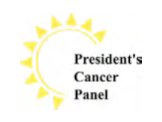Submitted by Norm Roulet on Thu, 05/20/2010 - 01:05.

Below is What Individuals Can Do: Recommendations: from the 2008–2009 Annual Report of the President’s Cancer Panel - REDUCING ENVIRONMENTAL CANCER RISK... What We Can Do Now - April 2010. This report is submitted to the President of the United States in fulfillment of the obligations of the President’s Cancer Panel.
Much remains to be learned about the effects of environmental exposures on cancer risk. Based on what is known, however, there is much that government and industry can do now to address environmental cancer risk. The Panel’s recommendations in this regard are detailed above. At the same time, individuals can take important steps in their own lives to reduce their exposure to environmental elements that increase risk for cancer and other diseases. And collectively, individual small actions can drastically reduce the number and levels of environmental contaminants.
CHILDREN
1. It is vitally important to recognize that children are far more susceptible to damage from environmental carcinogens and endocrine-disrupting compounds than adults. To the extent possible, parents and child care providers should choose foods, house and garden products, play spaces, toys, medicines, and medical tests that will minimize children’s exposure to toxics. Ideally, both mothers and fathers should avoid exposure to endocrine-disrupting chemicals and known or suspected carcinogens prior to a child’s conception and throughout pregnancy and early life, when risk of damage is greatest.
CHEMICAL EXPOSURES
2. Individuals and families have many opportunities to reduce or eliminate chemical exposures. For
example:
- Family exposure to numerous occupational chemicals can be reduced by removing shoes before entering the home and washing work clothes separately from the other family laundry.
- Filtering home tap or well water can decrease exposure to numerous known or suspected carcinogens and endocrine-disrupting chemicals. Unless the home water source is known to be contaminated, it is preferable to use filtered tap water instead of commercially bottled water.
- Storing and carrying water in stainless steel, glass, or BPA- and phthalate-free containers will reduce exposure to endocrine-disrupting and other chemicals that may leach into water from plastics. This action also will decrease the need for plastic bottles, the manufacture of which produces toxic by-products, and reduce the need to dispose of and recycle plastic bottles.
- Similarly, microwaving food and beverages in ceramic or glass instead of plastic containers will reduce exposure to endocrine-disrupting chemicals that may leach into food when containers are heated.
- Exposure to pesticides can be decreased by choosing, to the extent possible, food grown without pesticides or chemical fertilizers and washing conventionally grown produce to remove residues.
- Similarly, exposure to antibiotics, growth hormones, and toxic run-off from livestock feed lots can be minimized by eating free-range meat raised without these medications if it is available.
- Avoiding or minimizing consumption of processed, charred, and well-done meats will reduce exposure to carcinogenic heterocyclic amines and polyaromatic hydrocarbons.
- Individuals can consult information sources such as the Household Products Database to help them make informed decisions about the products they buy and use.
- Properly disposing of pharmaceuticals, household chemicals, paints, and other materials will minimize drinking water and soil contamination.
- Individuals also can choose products made with non-toxic substances or environmentally safe chemicals.
- Similarly, reducing or ceasing landscaping pesticide and fertilizer use will help keep these chemicals from contaminating drinking water supplies.
- Turning off lights and electrical devices when not in use reduces exposure to petroleum combustion by-products because doing so reduces the need for electricity, much of which is generated using fossil fuels.
- Driving a fuel-efficient car, biking or walking when possible, or using public transportation also cuts the amount of toxic auto exhaust in the air.
- Individuals can reduce or eliminate exposure to secondhand tobacco smoke in the home, auto, and public places. Most counseling and medications to help smokers quit are covered by health insurance or available at little or no cost.
RADIATION
3. Adults and children can reduce their exposure to electromagnetic energy by wearing a headset when using a cell phone, texting instead of calling, and keeping calls brief.
4. It is advisable to periodically check home radon levels. Home buyers should conduct a radon test in any home they are considering purchasing.
5. To reduce exposure to radiation from medical sources, patients should discuss with their health care providers the need for medical tests or procedures that involve radiation exposure. Key considerations include personal history of radiation exposure, the expected benefit of the test, and alternative ways of obtaining the same information. In addition, to help limit cumulative medical radiation exposure, individuals can create a record of all imaging or nuclear medicine tests received and, if known, the estimated radiation dose for each test.
6. Adults and children can avoid overexposure to ultraviolet light by wearing protective clothing and
sunscreens when outdoors and avoiding exposure when the sunlight is most intense.
SELF-ADVOCACY
7. Each person can become an active voice in his or her community. To a greater extent than many realize, individuals have the power to affect public policy by letting policymakers know that they strongly support environmental cancer research and measures that will reduce or remove from the environment toxics that are known or suspected carcinogens or endocrine-disrupting chemicals. Individuals also can influence industry by selecting non-toxic products and, where these do not exist, communicating with manufacturers and trade organizations about their desire for safer products.
 Reports
Reports
 Annual Report for 2008-2009
Annual Report for 2008-2009 
Reducing Environmental Cancer Risk, What We Can Do Now
April 2010
For further information on the President’s Cancer Panel
or additional copies of this report, please contact:
Abby B. Sandler, Ph.D.
Executive Secretary
President’s Cancer Panel
6116 Executive Boulevard
Suite 220, MSC 8349
Bethesda, MD 20814-8349
301-451-9399
pcp-r [at] mail [dot] nih [dot] gov
http://pcp.cancer.gov